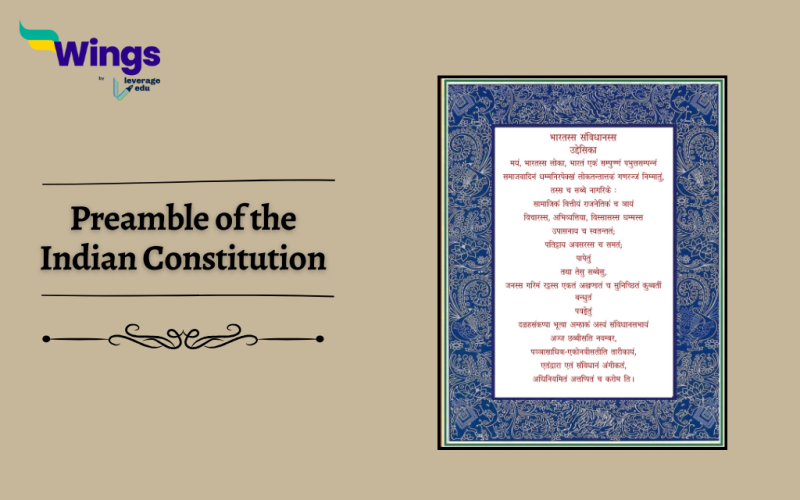In the mosaic of India’s constitutional framework, the Preamble stands tall as a guiding beacon, encapsulating the aspirations, values, and objectives of our nation. Moreover, the Preamble is usually and proudly referred to as the Soul of the Indian Constitution. It serves as a Preamble not only as the legal document but also to our Nation’s journey towards justice, liberty, equality, and fraternity. Let us dive deeper into the essence of the Preamble of the Indian Constitution.
The Preamble (picture taken at Pradhanmantri Sangrahalaya, Delhi)
What is the Timeline and History of the Preamble?
Table of Contents [show]
Our Preamble is based on the Objective Resolution.
| Timeline of the Preamble of our Indian Constitution | |
| Timeline | Date |
| Jawaharlal Nehru moved in the Constituent Assembly | 13th of December, 1946 |
| Accepted by the Constituent Assembly | 22nd of January, 1947 |
| Adopted by the Constituent Assembly | 26th of November, 1949 (National Constitution Day) |
| Came into Force | 26th of January, 1950 (Republic Day) |
What are the Amendments to the Preamble of the Indian Constitution?
During the Emergency, the 42nd Amendment on the 18th of December, 1976 added the words, Secular and Socialist to the existing ‘Sovereign Democratic Republic.’ Additionally, “unity and integrity of the Nation” was added to “unity of the Nation.”
Moreover, in 1994, through the S. R. Bommai v. Union of India case, the Supreme Court of India declared that Secularism constitutes an integral component of the Basic Structure Doctrine.
It is intriguing to note that in a Constitution Amendment Bill, in the winter session of parliament in 2021, a legislator, KJ Alphons proposed the introduction of a Bill aimed at amending the Preamble.
Also Read: Article 21: Right to Life and Right to Personal Liberty
Which Artists Created the Preamble?
The Preamble page was designed by the artist Beohar Rammanohar Sinha of Jabalpur. At the time, Sinha was collaborating with Acharya Nandalal Bose at Shantiniketan. Moreover, Nandalal Bose, who decorated the original manuscript of the Indian Constitution wholeheartedly approved of Sinha’s artwork without making any alterations. Consequently, Sinha’s brief signature “Ram” in the Devanagari script adorns the lower-right corner of the Preamble.
The calligraphy of the Indian Constitution was entirely written by Prem Behari Narain Raizada. He was a generational calligraphist with his grandfather’s name as well as his own written at the end of our Indian Constitution.
Also Read: Making of the Indian Constitution
What are the Sources of the Preamble?
The Sources of the Preamble are as follows:
- The idea of a Preamble has been borrowed from The Constitution of the United States of America.
- The Constitution of the Soviet Union (now Russia) gave us the ideal of ‘Justice, social, economic and political’
- The French Constitution gave ‘Republic’ and the ideals of ‘Liberty, Equality and Fraternity.’
Also Read: Sources of the Indian Constitution
What are the Components of the Preamble?
The Preamble starts with the declaration, “We, the people of India,” accentuating the Sovereignty of the Indian people, whilst marking a departure from British colonial rule. Moreover, the Preamble outlines the core principles and objectives that the Indian Constitution seeks to uphold:
- Sovereign: Declaring India’s complete independence from any foreign authority.
- Socialist: Reflecting the commitment towards a welfare state, hence making sure of equal distribution of resources and opportunities.
- Secular: Establishing India’s impartiality towards all religions to encourage a harmonious as well as inclusive society.
- Democratic: Glorifying the principles of representative Democracy, thus securing governance by the people, for the people, and of the people.
- Republic: Establishing India as a sovereign republic, with elected representatives accountable to the people.
- Justice: Striving for social, economic, and political justice and hence ensuring equality before the law.
- Liberty: Guaranteeing individual freedom of thought, expression, belief, faith, and worship.
- Equality: Promoting equality of status and opportunity, irrespective of caste, creed, gender, or economic status.
- Fraternity: Nurturing a spirit of brotherhood and unity among all people which transcends barriers of religion, language, and region.
FAQs
The Preamble to the Indian Constitution was drafted and composed by members of the Constituent Assembly. While it is not attributed to a single individual, prominent figures such as B.R. Ambedkar, and other members of the drafting committee played significant roles in shaping its content. Moreover, the artist Beohar Rammanohar Sinha of Jabalpur designed the Preamble.
There aren’t 5 Preambles of the Indian Constitution. However, there are 5 ideals which are Sovereign, Socialist, Secular, Democratic and Republic.
The first word of the Preamble is “We” and then constituting We, it is “the People of India” which signifies that the Preamble is by the people, for the people and of the people of India.
Lastly, we hope you liked our blog and gained an understanding of the Preamble of the Indian Constitution. Moreover, you may even read more blogs and empower yourself with knowledge regarding Civics and Polity!
 One app for all your study abroad needs
One app for all your study abroad needs















 45,000+ students trusted us with their dreams. Take the first step today!
45,000+ students trusted us with their dreams. Take the first step today!
